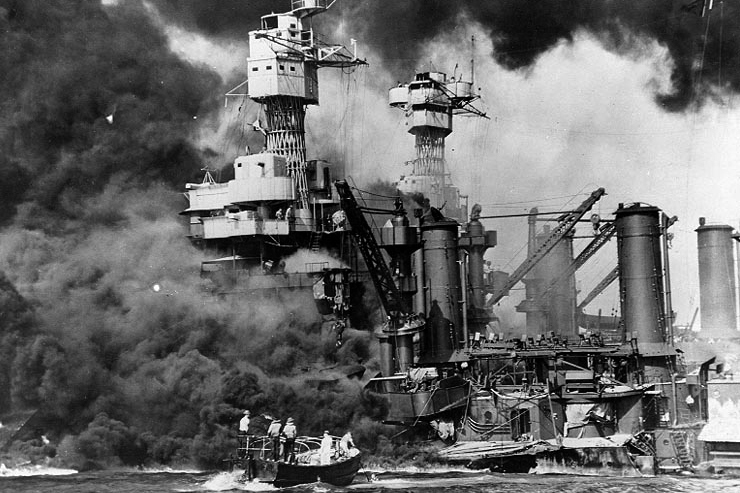
In the aftermath of the September 11 terrorist attacks, the Pearl Harbor metaphor suddenly, if not naturally, emerged in the United States. As it happens, the year 2001 was the sixtieth anniversary of the Japanese attack on Pearl Harbor and, perhaps not coincidentally, the film Pearl Harbor was released in May of that year, providing a symbolic resource for experiencing and understanding September 11 (Rosenberg, 2003).
For the past 20 years, many scholars have referred to Pearl Harbor as an invoked historical reference after September 11 in the US media landscape (e.g., Brennen & Duffy, 2003; Conner, 2012; Winfield, Friedman, & Trisnadi, 2002). Intriguingly, however, little has been known about how the reference to Pearl Harbor was made in the Japanese media landscape. Rosenberg (2003) vividly illuminates the role of the Pearl Harbor icon in shaping the cultural dynamics of American history and asserts that: “Pearl Harbor stories tend to be nation-centric. The attack on Pearl Harbor, after all, is hardly a major iconic event for other countries – even for Japan” (p. 188).
With a different national history, how was Pearl Harbor’s icon applied to the September 11 terrorist attacks in the Japanese media and journalism landscape? This study examines how major Japanese newspapers referred to Pearl Harbor after the September 11 attacks to address the question. Doing so indicates how Japanese journalism in general remembered and forgot memories of Japan’s attack on Pearl Harbor 60 years later.
Dataset and method
The newspaper articles were retrieved from the online archives of three Japanese national newspapers: the Asahi Shimbun, the Yomiuri Shimbun, and the Mainichi Shimbun. They represent three of the largest-circulation national newspapers in Japan (Fujitake, 2012). Articles that appeared not explicitly related to the September 11 terrorist attacks and Pearl Harbor were excluded during the coding process. Specifically, they constitute all the articles that refer to both “同時多発テロ“ (The simultaneous terrorist attacks) and “真珠湾” (Pearl Harbor) published by the three newspapers from September 11, 2001, to December 31, 2001. The unit of analysis was an article and textual corpus consisting of 27 articles (The Asahi), 20 articles (The Yomiuri), and 33 articles (The Mainichi). I conducted a content analysis using standard coding and proposed three dominant ways of using the icon of Pearl Harbor after September 11: Describing the scale of September 11, rewriting Japan-United States relations, and justifying the US’s retaliation against terrorists.
Pearl Harbor and September 11 in Japanese national newspapers
The three newspapers did not discuss the metaphor of Pearl Harbor per se, but they uncritically used the term and quoted people referring to it, offering a symbolic resource for discussing September 11 in the Japanese media and journalism landscape. From the very beginning, the icon “Pearl Harbor” was invoked in the Japanese media landscape to describe the scale of September 11. For instance, on September 12, 2001, Shunji Taoka, the Asahi newspaper journalist and military commentator, noted:
The American death toll from the attack on Pearl Harbor in December of 1941 was 2,403. The number of victims of the attacks on the World Trade Center in New York and the Pentagon in the suburbs of Washington, D.C. on [September] 11 is still unclear, but FOX TV reported an estimate of “about 10,000 dead,” which, given the circumstances, presumably far exceeds the damage at Pearl Harbor. (The Asahi Shimbun, 2001, p. 2)
Taoka spontaneously conveyed the view of the estimated scale of the terrorist attacks by evoking the memory of what the Japanese inflicted on Pearl Harbor 60 years earlier. The immediate reference to the historical past is striking, given that Japanese task forces that attacked Pearl Harbor were unreflexively compared to terrorists in the twenty-first century within the reference. Taoka thus framed the terrorist attack by using the icon of Japan’s attack as just one of the objective indicators to measure the scale of its damage.
Not surprisingly, the invoked icon of Pearl Harbor foregrounded the issue of Japan-United States relations. In the Yomiuri Shimbun (2001), Tarō Nakayama, a conservative politician, was reported as saying the following only 2 days after the terrorist attacks:
What is unfortunate for Japan is that the expression “since the attack on Pearl Harbor” was heard in the United States. It is a pity that the image of Japan as an ally under the Japan-U.S. Treaty of Mutual Security and Cooperation will be returned to its old image. (p. 6)
Just as Maginer (2001) reported, the icon may have “upset Japan”, but more importantly, the icon was strategically used for severing the sense of historical continuity through the emphasis of the historical break between Imperial Japan and postwar Japan, leaving aside the issue of Japan’s wartime responsibility for attacking Pearl Harbor. The Japanese newspaper published his statement and uncritically provided a view of preserving Japan’s attacks on Pearl Harbor as a thing of the past, or more directly, irrelevant to the present for a contemporary audience in Japan.
Simultaneously, the Pearl Harbor icon was used to justify the US’s direct retaliation against the terrorists. Among many articles, for instance, Shintarō Ishihara, a conservative politician and then the Governor of Tokyo, was reported as saying in the Mainichi Shimbun (2001) that:
Some people compare it [the September 11] to the attack on Pearl Harbor, but it is similar to the atomic bombing in that innocent civilians were killed. This incident is too much… If you don’t call this a war, you are a fool. Retaliation is natural. (p. 29)
The icon was used to evoke the US’s memory of revenge against the evil of that time (Japan) in the Japanese media and journalism landscape, but Ishihara also highlighted Japan’s memory of atomic bombings by the United States as a historical reference to September 11. In any case, the Pearl Harbor icon was used to foreground the notion of war without mentioning the enemy of that time by name, contributing to the justification of American retaliation against terrorists. Ultimately, Japanese newspapers unreflexively contributed to the invocation of the Pearl Harbor icon for framing the terrorist attacks for a contemporary audience in Japan.
Conclusion
The Japanese national newspapers referred to the Pearl Harbor icon as a key historical reference for discussing the September 11. In doing so, the memories of Pearl Harbor were further forgotten in the Japanese media and journalism landscape. The Japanese newspapers not only promoted the forgetting of Japanese aggression against the United States but also helped make individual wartime Japanese pilots attacking Pearl Harbor faceless others for the contemporary Japanese audiences. As such, the icon was used as a rhetorical resource without a sense of history for bringing Japan and the United States even closer together in the post-9/11 Japanese media and journalism landscape. Ultimately, the major Japanese newspapers unanimously came to approve force against terrorists by the United States (Abe, 2004).
This study focused exclusively on examining major Japanese newspapers, leaving aside the analysis of other media, such as television and the Internet, but it indicates how Japanese journalism not merely referred to the icon of Pearl Harbor after September 11 but also contributed to forgetting the memories of Pearl Harbor by doing so.
About the author: Yasuhito Abe is currently Senior Assistant Professor at the Faculty of Global Media Studies at Komazawa University, Tokyo Japan. His research interests involve citizen science, data activism and media, communication and journalism histories.
Featured Image: “Pearl Harbor,” via the U.S. Army (CC BY 2.0)
References
Abe, Y. (2004). 9.11 jiken ikō no Asahi shimbun, Mainichi shimbun, Yomiuri shimbun no ichi kōsatsu: Asahi shimbun, Mainichi shimbun, Yomiuri shimbun shasetsu o daizai ni [An analysis of Japanese newspaper editorials following the September 11 attacks]. Shimbungaku 19, 18-76.
The Asahi Shimbun. (2001, September 12). Soshikiteki tero ni shōgeki: Radin shi kanyo nōkō bei no dōji tahatsu tero [Shock of organized terrorism: Bin Laden strongly implicated in attacks on the United States]. Asahi Shimbun (evening edition), p. 2.
Brennen, B., & Duffy, M. (2003). “If a problem cannot be solved, enlarge it”: An ideological critique of the “other” in Pearl Harbor and September 11 New York Times Coverage. Journalism Studies, 4(1), 3-14. https://doi.org/10.1080/14616700306504
Connor, B. T. (2012). 9/11–A new Pearl Harbor? Analogies, narratives, and meanings of 9/11 in civil society. Cultural Sociology, 6(1), 3-25.
Fujitake, A. (2012). Zusetsu nihon no media [Illustrations on Japan’s media]. NHK Shuppan.
Maginer, M. (2001, September 13). Pearl Harbor comparisons upset Japan. The Los Angeles Times. https://www.latimes.com/archives/la-xpm-2001-sep-13-mn-45282-story.html
The Mainichi Shimbun. (2001, September 15). Beikoku dōji tahatsu tero “Mukankei no minkanjin ga gisei, shinjuwan dewa naku gembaku tōka. [Unrelated civilians were victimized. September 11 is not Pearl Harbor but the dropping of an atomic bomb]. Mainichi Shimbun, p. 29
Rosenberg, E. S. (2003). A date which will live: Pearl Harbor in American memory. Duke University Press.
Winfield, B. H., Friedman, B., & Trisnadi, V. (2002). History as the metaphor through which the current world is viewed: British and American newspapers’ uses of history following the 11 September 2001 terrorist attacks. Journalism Studies, 3(2), 289-300. https://doi.org/10.1080/14616700220130043
The Yomiuri Shimbun. (2001, September 13). Bei douji tero senmonka zadankai [A round-table talk about September 11 by Japanese experts]. The Yomiuri Shimbun, p. 6.

